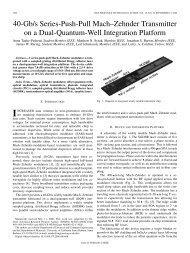Noise figure of vertical-cavity semiconductor optical amplifiers ...
Noise figure of vertical-cavity semiconductor optical amplifiers ...
Noise figure of vertical-cavity semiconductor optical amplifiers ...
You also want an ePaper? Increase the reach of your titles
YUMPU automatically turns print PDFs into web optimized ePapers that Google loves.
BJÖRLIN AND BOWERS: NOISE FIGURE OF VCSOAs 65Fig. 5. Fiber-to-fiber gain and fiber-to-fiber noise <strong>figure</strong> versus input signalpower for P=P = 0:9.the OSA, and the frequency range <strong>of</strong> interest that these measurementsare associated with some uncertainty.Electrical measurement techniques give a more completecharacterization <strong>of</strong> the noise <strong>figure</strong>. The output noise from theamplifier is measured using a calibrated receiver and electricalspectrum analyzer. The thermal noise from the detector andshot noise is subtracted from the measured noise and an idealshot noise term ( ) is added. The noise <strong>figure</strong> is given by thefollowing equation [18]:(12)where is the measured and corrected electrical noise spectrumin /Hz as a function <strong>of</strong> electrical frequency, andis the input signal power. The input signal power was in theexperiment controlled by means <strong>of</strong> a variable <strong>optical</strong> attenuator.The attenuation <strong>of</strong> the signal minimizes the excess noise <strong>of</strong>the signal that could otherwise affect the measurements. <strong>Noise</strong>spectra were measured from 0 to 10 GHz, for different inputsignal powers, and the noise <strong>figure</strong> was calculated using (12).<strong>Noise</strong> <strong>figure</strong> and fiber-to-fiber gain forareshown in Fig. 5. Results from <strong>optical</strong> measurements are alsoshown in the <strong>figure</strong>. For low input signal power ( 30 dB and25 dB), gain <strong>of</strong> about 13 dB was measured. The noise <strong>figure</strong>given by the electrical method was about 9 dB. In this regime,the gain has not yet started to saturate and the gain and carrierdensity are unaffected by the input signal. The <strong>optical</strong> method isvalid in this regime. The noise <strong>figure</strong> given by <strong>optical</strong> measurementsis about 0.5 dB higher than that given by electrical measurements.For higher input signal powers, the <strong>optical</strong> methodgives values that are too high, as the measured ASE density ishigher than the ASE density when the signal is present. As theinput signal power increases the amplifier gain starts to saturate.In this regime the carrier density in the QWs is depletedby the signal. The reduction in carrier density naturally causesa decrease in gain and yields an increased population inversionparameter. The decreased gain results in a power reduction <strong>of</strong>both output signal power and ASE power. The signal power,however, decreases faster resulting in degradation <strong>of</strong> the noise<strong>figure</strong>. It has been shown that at low electrical frequencies, thegain saturation causes a decrease in output noise resulting in alow-frequency noise <strong>figure</strong> considerably lower than the broadFig. 6. <strong>Noise</strong> spectrum and noise <strong>figure</strong> for P=P =0:9 and 010-dBm inputsignal power.band noise <strong>figure</strong> [20]. The bandwidth <strong>of</strong> the low frequency dipin the noise spectrum is inversely proportional to the carrier lifetimeand hence more significant in SOAs compared to fiber <strong>amplifiers</strong>[20]. A spectrum <strong>of</strong> the output noise and the noise <strong>figure</strong>for 93 mW <strong>of</strong> pump power and 10 dBm <strong>of</strong> signal is shownin Fig. 6. A noise <strong>figure</strong> smaller than 5 for frequencies below1 GHz is demonstrated. The broadband noise <strong>figure</strong> is in thiscase about 10.The measurements are, in general, in good agreement withtheory. In the small signal regime, the measured noise <strong>figure</strong> <strong>of</strong>about 9 dB is close to the theoretical value <strong>of</strong> 8.7 dB. The deviationcan be attributed to operation at slightly lower carrierdensity and uncertainties in the calculation <strong>of</strong> , as well asin the estimate <strong>of</strong> the input coupling loss. The intrinsic noise<strong>figure</strong> <strong>of</strong> the present device trails those reported for in-plane devices[21], [22]. The superb coupling efficiency, however, yieldsan excellent fiber-to-fiber noise <strong>figure</strong>. The present device isclearly limited by a large population inversion parameter. Reducedmirror reflectivity would allow for stronger pumping andthereby a more favorable population inversion.IV. CONCLUSIONWe have investigated the noise <strong>figure</strong> <strong>of</strong> VCSOAs. Our initialresults are promising; low noise <strong>figure</strong>s can be expected fromfuture devices. The noise <strong>figure</strong> is strongly affected by the reflectivity<strong>of</strong> the mirrors. The signal-spontaneous beat-noise enhancement( ) can be eliminated by choosing proper mirror reflectivities.For the case <strong>of</strong> transmission-mode operation, lowinputmirror reflectivity is desired in order to minimize .Forreflection-mode operation, the bottom mirror reflectivity shouldbe maximized to minimize , which for this case is independent<strong>of</strong> top mirror reflectivity. Highly reflective mirrors leadto lasing at relatively low carrier densities, which sets a limitto the possible population inversion. This is <strong>of</strong> more concernthan the signal-spontaneous beat-noise enhancement. We havepresented experimental results for the noise <strong>figure</strong> <strong>of</strong> a 1.3- mVCSOA operated in reflection mode. The results are in goodagreement with theory. The present devices have top mirror reflectivity(0.955) that is too high; the onset <strong>of</strong> lasing makes itimpossible to achieve a population inversion below 3. Despitethis, fiber-to-fiber noise <strong>figure</strong>s on the order <strong>of</strong> 9 dB were measured.This clearly demonstrates that the superb coupling ef-



